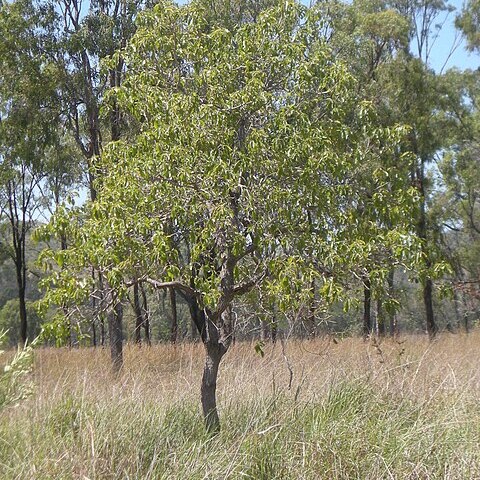Deciduous trees, 3-15 m high. Bark up to 1 cm thick, suberose, scaly, deeply fissured, greyish brown; living bark red; wood light grey outside, red in the centre, closed grain, tough. Branchlets terete, striate, lenticellate, grey or brownish grey (dry), cylindrical, 2-5 mm thick; leaf-scars distinct, leaf-traces sometimes visible. Leaves: petiole c. 2 cm, rarely up to 3 cm; blade obovate to broadly oval, the smallest leaves spathulate, (1-) 2.3-8.2 by (1.5-)3-6 cm, papyraceous, slightly areolate, base slightly decurrent, margin finely crenulate, apex emarginate to bluntly acuminate, in the latter case acumen very short (< 5 mm), tip obtuse, upper surface somewhat glossy, lower surface dull; midrib strongly prominent on the lower surface, flat above, lateral nerves 9-12 pairs, making an angle of c. 60° with the midrib, arcuately and faintly anastomosing near the margin, often branched, prominulous, veinlets ending in a mucro at the sinus. Inflorescences racemes, few-flowered; rachis 0.5-7 cm long, pulverulent to puberulous; bracts sometimes absent and pedicels subtended by small leaves; bracteoles cordate-ovate, 4-6 mm long, ciliate-denticulate, especially at the apex. Pedicels puberulous, (2-)8-15 mm long, c. 2 mm thick. Calyx tube and lobes puberulous outside, tube c. 1 cm long, campanulate, attenuate at the base, smooth, green; lobes ovate to semi-orbicular, unequal, the largest one c. 6 by 6 mm, the smallest one c. 3 by 5 mm, coriaceous, margin distinctly or obscurely ciliate. Petals obovate-oblong, 20(-30) by c. 17 mm, papyraceous, base tapering, not ciliate, apex obtuse, white, pink at the base, greenish on the back. Stamens 3-5 cm long; tube pink, 1-5 mm high; lower part of the free stamens pink, upper part white; anthers c. 1 mm long, 0.5 mm wide. Disc rim c. 1 mm high. Style c. 4 cm long. Fruits obovoid to ellipsoid, smooth, up to 7.5 cm (including calyx lobes) by 3 cm, with thick, fibrous pericarp. Seeds many, compressed-oval, c. 5 mm long, seedcoat brown to silvery brown, c. 0.3 mm thick; radicle curved.
More
Tree to 15 m high, deciduous; bark fissured, corky. Leaves: lamina spathulate, obovate to broadly ovate, mostly 2.5– 10 cm long, 3–6 cm wide, cuneate at base, crenulate margin, emarginate to obtusely acuminate at apex, glabrous, glossy above, dull below, often reddish; petiole 0.5–3 cm long. Racemes few-flowered; pedicels mostly 8–20 mm long; bracteoles cordate-ovate, 4–6 mm long. Calyx-tube papillose-hirsute, 5–15 mm long, narrow at base; lobes ovate to semi-elliptic, ciliate, 3–11 mm long, 5–8 mm wide. Petals obovate-oblong, 10–45 mm long, 10–17 mm wide, white and pink. Staminal tube 1–11 mm long, pink; filaments 20–45 mm long, white. Style 4–7 cm long. Fruit obovoid to ellipsoidal, smooth, to 9 cm long, 3.7 cm wide; pericarp thick, fibrous. Seed compressed-oval, c. 5 mm long.
A tree which loses its leaves during the year. It grows 4-15 m high and spreads 2-5 m wide. The bark is grey and corky. The leaves are simple and 2-10 cm long by 3-6 cm wide. The leaves are broadly oval or spoon shaped. They are smooth and shiny above but dull underneath. The leaves turn red colour before they fall. The flowers are 8 cm across. They are pink and white and showy. The fruit is 50 mm long by 35 mm wide. They can be larger. They occur singly or in bunches. The fruit are produced in the axils of leaves or at the ends of branches. They contain several seeds. The seeds are 10-11 mm long by 7 mm wide. The flesh is edible.


